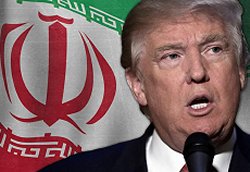
|
- Iran: Eight Prisoners Hanged on Drug Charges
- Daughter of late Iranian president jailed for ‘spreading lies’ - IRAN: Annual report on the death penalty 2016 - Taheri Facing the Death Penalty Again - Dedicated team seeking return of missing agent in Iran - Iran Arrests 2, Seizes Bibles During Catholic Crackdown
- Trump to welcome Netanyahu as Palestinians fear U.S. shift
- Details of Iran nuclear deal still secret as US-Tehran relations unravel - Will Trump's Next Iran Sanctions Target China's Banks? - Don’t ‘tear up’ the Iran deal. Let it fail on its own. - Iran Has Changed, But For The Worse - Iran nuclear deal ‘on life support,’ Priebus says
- Female Activist Criticizes Rouhani’s Failure to Protect Citizens
- Iran’s 1st female bodybuilder tells her story - Iranian lady becomes a Dollar Millionaire on Valentine’s Day - Two women arrested after being filmed riding motorbike in Iran - 43,000 Cases of Child Marriage in Iran - Woman Investigating Clinton Foundation Child Trafficking KILLED!
- Senior Senators, ex-US officials urge firm policy on Iran
- In backing Syria's Assad, Russia looks to outdo Iran - Six out of 10 People in France ‘Don’t Feel Safe Anywhere’ - The liberal narrative is in denial about Iran - Netanyahu urges Putin to block Iranian power corridor - Iran Poses ‘Greatest Long Term Threat’ To Mid-East Security |
Monday 06 February 2012Iran thought to be boosting nuclear work, sources say
VIENNA — Iran is believed to be expanding uranium enrichment activity deep inside a mountain, diplomatic sources said Monday, a move likely to add to tension with Western powers that suspect Tehran is seeking nuclear weapons capability. The move to increase sensitive nuclear work at the Fordow underground site near the Shiite Muslim holy city of Qom, even if expected, underlines the Islamic state's defiance in the face of intensifying Western pressure to curb such activity. Iran last month confirmed it had begun refining uranium to a fissile concentration of 20 percent at Fordow, shifting its highest-grade enrichment from an above-ground location to better protect it against any strikes by Israel or the United States. Washington, which has not ruled out military action against Iran if diplomacy fails to resolve the long-running nuclear dispute, on January 9 denounced the start-up of the Fordow plant as a further escalation of Iran's "ongoing violations" of U.N. resolutions. At that time, diplomats said Iran was operating at Fordow two so-called cascades, each of 174 centrifuges - machines that spin at supersonic speed to increase the ratio of the fissile isotope. More centrifuges were being installed, they said. Enriched uranium can have both civilian and military uses. One Vienna-based diplomat said two more cascades, like the first pair connected with each other to make the process more efficient, had now also been deployed to enrich uranium. "The second set of cascades is operational ... my understanding is they are both operational and (have) no problems," the diplomat said. Another diplomat accredited to the IAEA also painted a picture of expanding activity at Fordow, without giving details. Neither Iran nor the International Atomic Energy Agency (IAEA), the Vienna-based U.N. agency that regularly inspects Iranian nuclear sites including Fordow, was immediately available for comment. Iran said last year that it would transfer its highest-grade uranium refinement work to Fordow from its main enrichment plant at Natanz, and sharply boost capacity. The decision to move work which the U.N. Security Council has called on Iran to suspend to an underground facility could further complicate diplomatic efforts to resolve the standoff peacefully. The United States and its allies say Iran is trying to develop the means to make atomic bombs, but Tehran insists its nuclear program is aimed at generating electricity and isotopes for medical treatment. President Barack Obama tightened sanctions on Iran another notch, the White House said Monday, targeting its central bank and giving U.S. banks new powers to freeze assets linked to the government. Iran two years ago started refining uranium to a fissile concentration of 20 percent at Natanz - far more than the 3.5 percent level usually required to power nuclear energy plants. Tehran says it will use 20 percent-enriched uranium to convert into fuel for a research reactor making isotopes to treat cancer patients, but Western officials say they doubt that the country has the technical capability to do that. In addition, they say, Fordow's capacity - a maximum of 3,000 centrifuges - is too small to produce the fuel needed for nuclear power plants, but ideal for yielding smaller amounts of high-enriched product typical of a nuclear weapons program. Nuclear bombs require uranium enriched to 90 percent, but Western experts say much of the effort required to get there is already achieved once it reaches 20 percent purity, shortening the time needed for any nuclear weapons "break-out." They give different estimates of how quickly Iran could assemble a nuclear weapon - ranging from as little as six months to a year or more. Western officials believe Iran has not yet decided whether it will indeed "weaponize" enrichment, but rather is seeking now solely to establish the industrial and scientific capacity to do so if needed for military and security contingencies. Iran disclosed the existence of Fordow to the IAEA only in September 2009 after learning that Western intelligence agencies had detected it. Copyright 2012 Thomson Reuters. |






